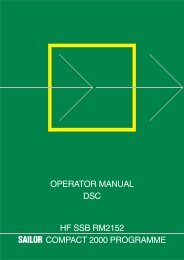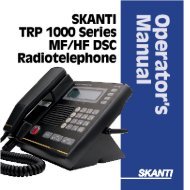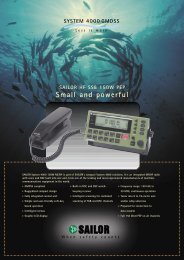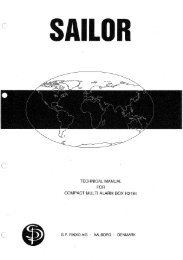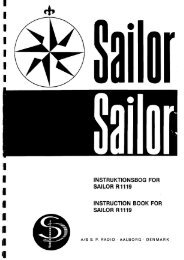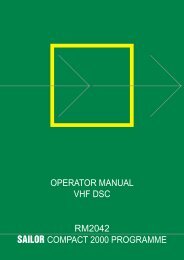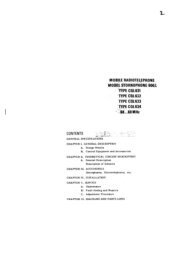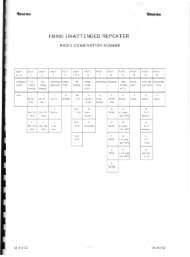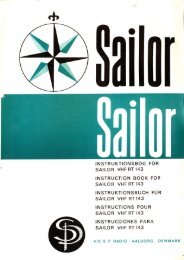TECHNICAL MANUAL FOR COMPACT VHF DSC RM2042
TECHNICAL MANUAL FOR COMPACT VHF DSC RM2042
TECHNICAL MANUAL FOR COMPACT VHF DSC RM2042
You also want an ePaper? Increase the reach of your titles
YUMPU automatically turns print PDFs into web optimized ePapers that Google loves.
3 SERVICE <strong>RM2042</strong>3.4 TROUBLE SHOOTINGTrouble shooting should only be performed by persons with sufficient technical knowledge, who have thenecessary measuring instruments at their disposal, and who have carefully studied the operationprinciples and structure of the <strong>VHF</strong> <strong>DSC</strong> <strong>RM2042</strong>.The first thing to check is whether the fault is somewhere in the antennea circuit, the power source, thehandset, or inside the <strong>RM2042</strong> it self.In order to help you during trouble shooting, the section 5. CIRCUIT DESCRIPTION AND SCHEMATICDIAGRAMS contains diagrams, principal descriptions, and drawings showing the location of theindividual components. Typical values for the DC and AC voltages are indicated in the diagrams, and alsothe test points are indicated in the diagrams.The <strong>RM2042</strong> has a number of trimming cores and trimmers, which must not be touched unlessadjustments as specified in section 3.6. ADJUSTMENT PROCEDURE can be made.When measuring inside the unit, short circuits must be avoided as the transistors would then be spoiled.3.5 PER<strong>FOR</strong>MANCE CHECKCHECK OF SYSTEM PER<strong>FOR</strong>MANCEWith this check procedure it is possible to control the performance of a hole <strong>VHF</strong> <strong>DSC</strong> system, whichinclude the <strong>DSC</strong> unit it self, the <strong>VHF</strong> tranceiver, a GPS receiver and a printer.The idea of this test procedure is first to key-in a call sequence and hereby control the connections to thekey board and display, and the function of these modules. The next step is to send the <strong>DSC</strong> call to yourself, which is done in the ‘CALL’ menu by keying-in the MID-number of the unit it self. The <strong>DSC</strong> call is nowgenerated by the microprocessor and the FSK encoder at the receiver module. The FSK signal is thenmodulating the connected <strong>VHF</strong> radiotelephone and a short piece of wire connected to the antennaterminal at the <strong>VHF</strong> will be sufficient to transfer the RF-signal to the channel-70 receiver. The receivedsignal is then demodulated, decoded, sampled and finally recognized by the microprocessor. As aresponse to the receiption of the call, the microprocessor will write the received message to the printerand at the same time generate a gated tone sequence for the internal loudspeaker.The primary force of this test is that the function of all modules is controlled and that the connections forexternal equipment are checked as well. An other force is the fact that the test procedure does not requireany test equipment.The check procedure can also be used as a function check after the system has been installed.1. Connect the <strong>RM2042</strong> to the <strong>VHF</strong> tranceiver, the printer and the GPS receiver (if available)2. Select the ‘FUNC’ menu and then the ‘Position’ menu. Control that the position data is updated bythe GPS receiver.3. Select the ‘CALL’ menu and press the ‘up-arrow’ button to key-in the MID-number of the <strong>DSC</strong> unitit self.4. Press ‘NEXT’ and select ‘Position’ by means of the ‘left-arrow’ and the ‘NEXT’ button.5. Press ‘NEXT’ and ‘SEND’ for transmission of the <strong>DSC</strong> call.6. The <strong>DSC</strong> call should now be received by the <strong>RM2042</strong> and the alarm signal will be heard in theinternal loudspeaker. The <strong>RM2042</strong> will write the received message to the printer.9403PAGE 3-3





